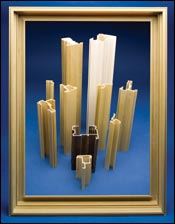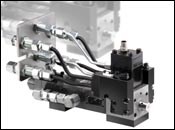What's New at the Show in PUR/RIM
At this year’s K show, look for the launch of fiberglass/polyurethane pultrusion into window frames, as well as several new high-efficiency mixing heads, MDI prepolymers for cast elastomers, and an energy-absorbing PUR foam for car bumpers. PUR pultruded windowsBayer MaterialScience will showcase polyurethane pultrusion technology, which recently has penetrated new applications.
At this year’s K show, look for the launch of fiberglass/polyurethane pultrusion into window frames, as well as several new high-efficiency mixing heads, MDI prepolymers for cast elastomers, and an energy-absorbing PUR foam for car bumpers.
PUR pultruded windows
Bayer MaterialScience will showcase polyurethane pultrusion technology, which recently has penetrated new applications. Bayer credits this success to its new Baydur PUL 2500 PUR resin, which is being used by Inline Fiberglass Ltd., Toronto, to manufacture window frames that are said to be superior to their aluminum, wood, and vinyl counterparts—and even to other thermosets.
Experienced in fiberglass pultrusion with unsaturated polyester, Inline is now pioneering in pultrusion of window frames using PUR, which reportedly can produce larger, stronger parts with thinner walls. “We can produce lighter profiles that are strong enough to be used in large frames, even curtain walls,” says Inline founder and chief engineer Stanley Rokicki. Compared with extruded PVC, pultruded window profiles are said to be eight times stronger and 40 times better heat insulators than aluminum. PUR profiles are also less brittle than conventional frames, so they won’t crack or splinter, resulting in superior fastening. PUR pultruded frames are also said to have excellent expansion and contraction properties, can withstand weather extremes from arctic blasts to desert heat and seaside moisture, and can be painted or finished to look like wood.
Innovation in machinery
Four companies are unveiling improved mixheads and metering systems,. From Cannon in Italy comes a new family of high-pressure L-shaped heads, called the Cannon JL (“jet-less”) series, in which mixing of the two reactive liquids is not achieved with two injectors. Instead, the two streams enter a narrow chamber where high turbulence provides good mixing, according to Cannon. At the end of the mixing chamber, the L-shaped geometry deviates the flow into a much larger chamber, where the turbulence abates and permits delivery of the mix with a very low laminar flow.
Cannon claims much more efficient mixing than with the usual impingement approach and the ability to reduce mixing pressure to 70 to 80 bar (1015 to 1160 psi), which permits simplifying the whole metering circuit (pump, filters, hoses, etc.). Also, a wider range of flow rates can be handled by the same mixing chamber, and the unit does not demand skilled operators to set the head’s injection conditions.
Cannon also points to a very long discharge duct that reportedly can enter hard-to-access pouring holes and guarantees a laminar flow even at high flow rates. The internal geometry of these units is said to allow for a better handling of foams expanded with high-frothing blowing agents such as HFCs or liquid CO2.
KraussMaffei has a new mixhead that is said to offer high-precision processing of very small volumes of PUR. The MK 3,5/5UL-2KVV reportedly ensures thorough mixing and pouring at a uniform rate, even at throughputs as low as 5 g/sec. The new head opens up the advantages of PUR high-pressure technology to low-volume applications that until now required low-pressure metering systems.
The discharge tube is at a 90º angle to the mixing chamber. This is said to reduce turbulence so that the mix emerges in a continuous, steady stream. The unit is self-cleaning and is said to be easy to handle and small enough to pour into hard-to-reach mold areas. The nozzles through which the PUR components enter the mixing chamber are in a double-V pattern said to ensure mixing. Nozzles can be changed individually, so the head can process different materials in different ratios.
Applications for this small-volume unit include glueing a metal strip to a car windscreen, adding a seal lip and rigid foam fill to slats for garage doors, direct application of gasketing, and molding small electronics.
Also designed for small outputs with high precision is the new MicroLine high-pressure metering machine from Hennecke Machinery, Div. of Bayer MaterialScience. With a minimum output of 5 g/sec, it is for production of PUR car interior parts such as gear-shift knobs, cable inserts, or small back-foamed parts. MicroLine is based on Hennecke’s TopLine high-pressure metering unit.
Also new from KraussMaffei is the K 2.0-2K-S-L mixhead, which is part of a PUR spray system for making high-quality skins for automotive components such as instrument panels, center consoles, and interior door trim. The new mixhead (also known as the Luchs II 2.0) is used with a special lance nozzle to spray accurately into complex geometries such as undercuts. Because there is no static mixer, the lance is reportedly easy to clean and provides long service life.
Prepolymers for casting
Bayer MaterialScience is introducing what it describes as a “breakthrough” in MDI cast elastomers. Baytec Max MDI amine-cured prepolymers reportedly allow formulators for the first time to make MDI-based polyurethane-urea hot-cast elastomers with superior mechanical properties and performance. Previously, the reaction of an MDI prepolymer with an aliphatic or aromatic amine was too fast to be of practical use. The new products can be processed on existing equipment similarly to standard TDI prepolymers but eliminate the concerns of TDI exposure.
Baytec Max prepolymers consist of novel polyester and polyether prepolymers produced from a specialty MDI. When extended with diamines such as MbOCA and MCDEA, they boast reactivities similar to TDI prepolymers, producing PUR-urea elastomers with comparable physical properties. Low viscosities at processing temperatures, outstanding abrasion and tear properties, and broader processing latitude than glycol chain-extended MDI hot-cast systems are also claimed.
Energy-absorbing bumper
A new energy-absorbing PUR foam from Bayer MaterialScience was used in a collaborative design effort with O-Flex Automotive, Inc., Rochester Hills, Mich., to produce bumper-system energy absorbers to meet new pedestrian protection requirements. A show highlight for Bayer, the patented O-Flex bumper design utilizes ultra-low-density Bayfill EA (energy-absorbing) foam to make a spin-formed, quadrangular metal tube with corrugated walls that can collapse on impact. The tube reportedly can withstand a series of multiple impacts with virtually no degradation in energy-absorption efficiency. Though providing better performance, the specific cost and mass of the energy absorber made with Bayfill EA is reportedly the same as current solutions utilizing alternative 4.0-pcf foam. Developed for the Cadillac STS, the foam-filled bumper assembly reportedly complies with European Commission pedestrian safety legislation and crash compatibility and also meets relevant NHSTA and IIHS crash-test ratings.
Other highlights
KraussMaffei will showcase a developmental application of automotive interior trim with its SkinForm process, in which liquid PUR overmolding is fully integrated with thermoplastic injection molding. This process was first shown at K 2004.
Cannon will also feature the latest technology for continuous and single-block production of conventional and viscoelastic flexible slabstock, including the latest versions of CarDio, C-Max, and Single Block foaming units. It also plans to unveil new solutions for the discontinuous mass production of large, flat or curved sandwich panels insulated with PUR, PIR, or phenolic foams.
BASF will highlight PUR advances in flexible foams for sports shoes.
Read Next
Understanding Melting in Single-Screw Extruders
You can better visualize the melting process by “flipping” the observation point so that the barrel appears to be turning clockwise around a stationary screw.
Read MoreAdvanced Recycling: Beyond Pyrolysis
Consumer-product brand owners increasingly see advanced chemical recycling as a necessary complement to mechanical recycling if they are to meet ambitious goals for a circular economy in the next decade. Dozens of technology providers are developing new technologies to overcome the limitations of existing pyrolysis methods and to commercialize various alternative approaches to chemical recycling of plastics.
Read MoreProcessor Turns to AI to Help Keep Machines Humming
At captive processor McConkey, a new generation of artificial intelligence models, highlighted by ChatGPT, is helping it wade through the shortage of skilled labor and keep its production lines churning out good parts.
Read More










.png;maxWidth=300;quality=90)

















